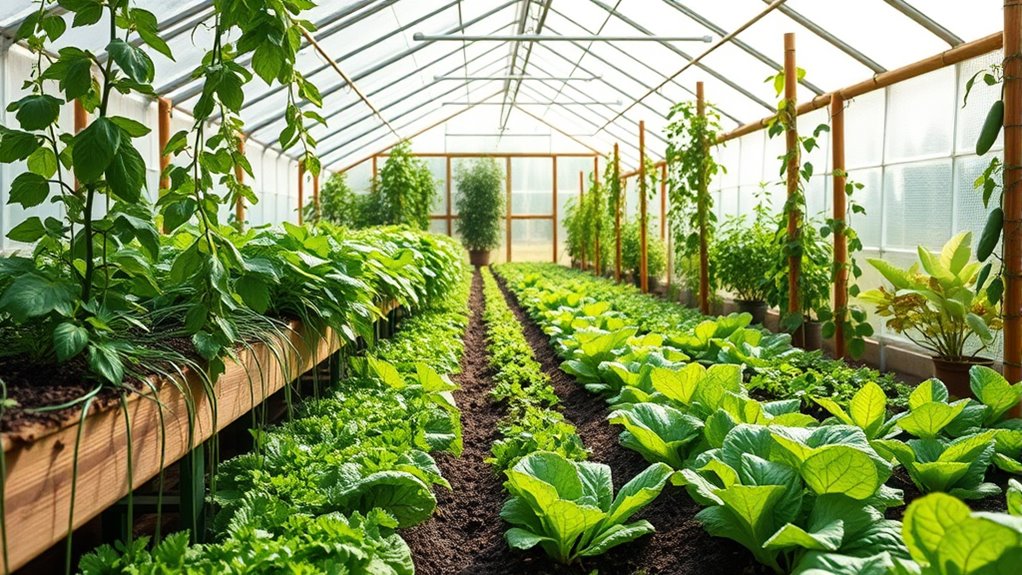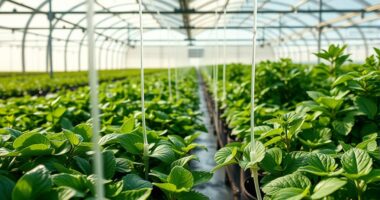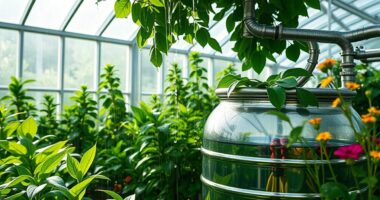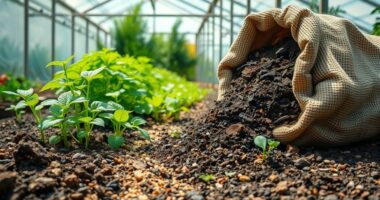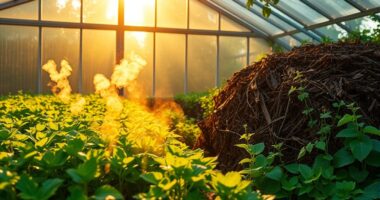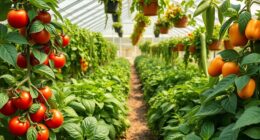To go organic and keep your greenhouse chemical-free, focus on natural pest control methods like introducing beneficial insects, using companion planting, and applying organic sprays like neem oil. Enhance ecosystem health with natural materials and proper mulching to improve soil and reduce pests. Use deep, infrequent watering and mulch to maintain moisture and prevent diseases. Creating a balanced environment supports pest resistance and plant vigor—continue exploring these techniques for a thriving, chemical-free greenhouse.
Key Takeaways
- Implement beneficial insects and companion planting to naturally control pests without chemicals.
- Use organic mulches and deep, infrequent watering to promote healthy soil and plant resilience.
- Apply organic sprays like neem oil or insecticidal soap for pest management when needed.
- Incorporate natural materials and biological controls to support ecosystem health and pest resistance.
- Maintain proper greenhouse hygiene and environmental conditions to prevent pest infestations naturally.
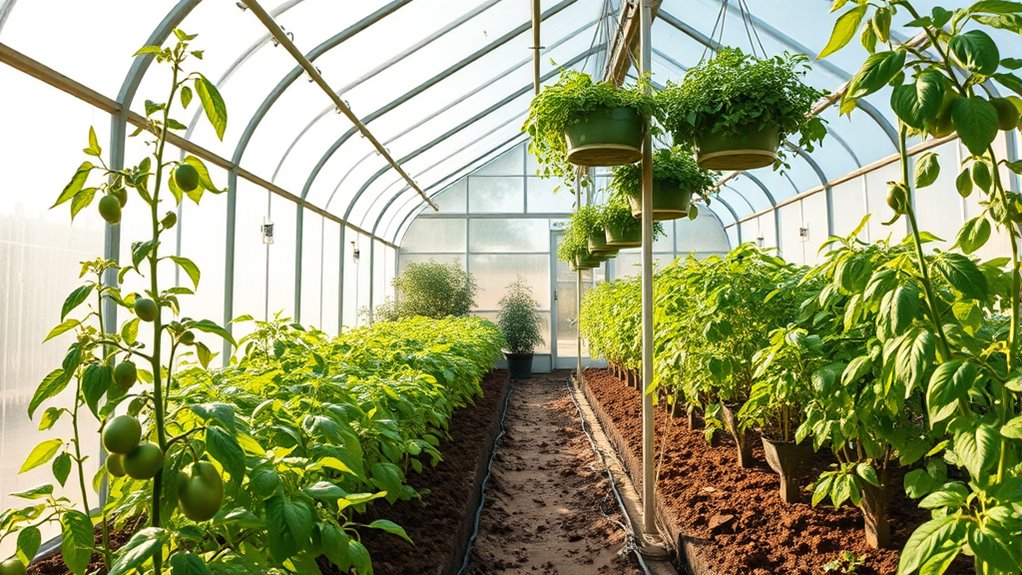
Greenhouse gardening methods offer an efficient way to grow plants year-round, regardless of outdoor weather conditions. When you choose to go organic, you’re committing to chemical-free practices that protect your plants, the environment, and your health. One of the key aspects of maintaining a healthy greenhouse ecosystem is effective pest control. Instead of relying on synthetic pesticides, you can use natural methods like introducing beneficial insects, such as ladybugs or predatory mites, which help keep pest populations in check. Companion planting also plays a crucial role; by growing certain plants together—like basil near tomatoes—you naturally deter pests and reduce the need for chemical interventions. Regularly inspecting your plants is essential, too, so you can catch any early signs of trouble. When you spot pests, remove them manually or use organic sprays made from neem oil or insecticidal soap, which are safe for your plants and non-toxic to you and beneficial insects. These methods not only eliminate pests effectively but also prevent the development of resistant pest populations over time. Additionally, incorporating natural materials into your greenhouse environment can enhance the overall health of your plants and support beneficial organisms. Using biological controls such as beneficial fungi or bacteria further promotes a resilient ecosystem and reduces reliance on amendments that might disrupt the balance. Incorporating companion planting techniques can also improve pest resistance and boost plant growth, creating a more sustainable environment. Watering techniques are another fundamental part of organic greenhouse gardening. Proper watering ensures your plants stay healthy and resilient against pests and diseases. Instead of overwatering or relying on frequent surface watering, focus on deep, infrequent watering to encourage strong root systems. Drip irrigation systems are ideal because they deliver water directly to the soil, minimizing excess moisture on foliage that could foster fungal growth. When watering, always aim for consistency; irregular moisture levels can weaken plants, making them more susceptible to pests and diseases. Mulching around your plants helps retain soil moisture, regulate temperature, and prevent weeds, which can harbor pests. Using organic mulch like straw, shredded leaves, or composted bark also adds nutrients to the soil as it breaks down. Proper watering and mulching create a balanced environment that discourages pests and emphasizes healthy, vigorous growth. Furthermore, understanding toilet-related issues can help gardeners avoid plumbing problems that might arise in greenhouse settings, especially if they are connected to water systems. Remember, good watering techniques not only support plant health but also create a less hospitable environment for pests and diseases, reducing your need for intervention.
Frequently Asked Questions
How Do I Control Pests Without Chemicals?
You can control pests without chemicals by using natural repellents like neem oil or garlic spray. Companion planting also helps—planting marigolds or basil around your crops deters pests naturally. Regularly inspect your plants for early signs of trouble, removing affected leaves promptly. Creating a balanced environment encourages beneficial insects like ladybugs, which prey on pests. These methods keep your greenhouse pest-free while maintaining an organic, chemical-free space.
What Organic Fertilizers Are Best for Greenhouses?
Did you know organic fertilizers can boost plant growth by up to 25%? For your greenhouse, consider using compost tea, which enriches soil with beneficial microbes, or fish emulsion, rich in nitrogen to promote lush foliage. Both are natural options that support healthy plants without chemicals. Regular application of these organic fertilizers helps maintain a sustainable, thriving greenhouse environment, ensuring your plants stay strong and productive.
How Can I Maintain Soil Health Naturally?
To maintain soil health naturally, you should focus on composting techniques and crop rotation. Composting adds essential nutrients and improves soil structure, while crop rotation prevents nutrient depletion and reduces pests. You can also plant cover crops like clover or legumes to fix nitrogen and protect the soil. By consistently applying these methods, you’ll keep your soil rich, healthy, and productive without relying on chemicals.
Are Organic Methods Cost-Effective Long-Term?
Organic methods can be cost-effective long-term if you effectively use composting techniques to enrich your soil naturally, reducing the need for expensive fertilizers. Additionally, implementing organic pest barriers minimizes chemical costs and environmental impact. While initial investments might seem higher, over time, these sustainable practices save money, promote healthier plants, and create a resilient garden ecosystem. Staying consistent with composting and pest management ensures ongoing savings and productivity.
How Do I Extend the Growing Season Organically?
You can extend your growing season organically by using techniques like companion planting and crop rotation. Companion planting helps protect crops from pests and improves growth, while crop rotation maintains soil health and prevents disease buildup. By planning your planting schedule carefully and utilizing season extenders like cold frames or row covers, you create a microclimate that shields plants from harsh weather, allowing you to harvest longer naturally.
Conclusion
Think of your greenhouse as a tiny, thriving jungle where nature’s harmony reigns. By choosing organic, chemical-free methods, you’re tending to this lush world with the care of a gentle gardener. Every healthy plant becomes a vibrant leaf in your lush canopy, showcasing the beauty of sustainable growth. When you nurture your greenhouse this way, you’re not just growing food—you’re cultivating a peaceful, thriving ecosystem, reminding us that nature’s balance is always within our hands to nurture.
